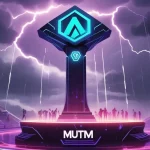Mutuum Finance Presale Hype: Next Ethereum or DeFi Bubble Waiting to Burst?

Mutuum Finance (MUTM) Presale Hype: Next Ethereum or Just Another DeFi Mirage?
Mutuum Finance (MUTM), a new DeFi protocol in its presale stage, is generating serious buzz with claims of Ethereum-level potential and whale investors piling in. With Phase 6 of its token sale nearly sold out and ambitious plans for a dual-lending platform, the project is positioning itself as a game-changer in decentralized finance. But behind the flashy numbers and bold promises, is MUTM a genuine innovator or just another speculative bubble waiting to pop?
- Presale Heat: Phase 6 is 95% sold out at $0.035 per token, with a jump to $0.04 looming—a 15% hike.
- Massive Raise: Nearly $19 million collected so far, with over 18,200 holders on board.
- Big Claims: Hyped as the “next Ethereum,” but with no working product to back up the bravado.
Breaking Down the MUTM Presale Frenzy
Let’s get straight to the numbers driving this hype. Mutuum Finance is deep into Phase 6 of its presale, having sold 95% of the 170 million tokens available at $0.035 each. Across all phases, the project has raised a staggering $18.95 million, pulling in a community of over 18,200 holders. With a total supply of 4 billion MUTM tokens, early birds who snagged tokens in Phase 1 at $0.01 are already sitting on a 350% gain. Promoters are even floating a potential listing price of $0.06, which would mean a 600% return for those early investors. Tempting? Sure. But let’s be real—those projections are as solid as a house of cards in a windstorm. We’ve seen too many projects dangle juicy gains only to vanish with investors’ funds.
MUTM’s Pitch: Dual-Lending and DeFi Dreams
At its heart, Mutuum Finance wants to stand out in the crowded DeFi space with a dual-lending model. This means it offers two ways to lend and borrow crypto assets: Peer-to-Contract (P2C) and Peer-to-Peer (P2P). For those new to DeFi, P2C is like lending through a middleman that’s not a person but a computer program—specifically, a smart contract on a blockchain. It handles the deal automatically, reducing the odds of getting stiffed by locking up collateral and enforcing terms. Think of it as a robo-bank with no late-night phone calls begging for repayments. P2P, on the other hand, is more direct—you lend straight to another user, often chasing higher returns but risking bigger losses if they don’t pay up. It’s like loaning cash to a buddy, except this buddy might be a stranger on the internet.
MUTM claims to blend the security of P2C (supporting “blue-chip” assets like Ethereum and USDT) with the high-yield potential of P2P, alongside other features like liquidity pools and what they call an “mtToken/debt token framework.” While details are thin, mtTokens might represent your stake in a loan or rewards for locking up funds, though we’re guessing here since the whitepaper isn’t exactly overflowing with clarity. They’re also promising automated liquidations—a critical safety net in DeFi lending. If a borrower’s collateral (say, their ETH) drops below a safe value due to market swings, the system sells it off automatically to cover the loan, protecting lenders from total loss. On paper, this sounds like a smart combo for risk-averse and risk-hungry users alike. But execution is everything, and we’re nowhere near seeing this in action.
Adding to the vision, MUTM plans an over-collateralized stablecoin system, using assets like Ethereum, Solana (SOL), and Avalanche (AVAX) as backing. For the uninitiated, over-collateralization means users lock up more value in assets than they borrow—think depositing $150 worth of ETH to borrow $100 in stablecoins. This cushions against price drops and aims to keep the stablecoin’s value steady, much like MakerDAO’s DAI has done with some success. If MUTM pulls this off, it could add a layer of utility. But building a stablecoin that doesn’t implode under stress is no small feat—just ask Terra/LUNA’s victims.
Roadmap and Reality: A Long Wait Ahead
The project’s timeline offers a glimpse of what’s planned, but it also underscores how far off we are from anything tangible. MUTM’s Version 1 protocol is slated for deployment on the Sepolia Testnet in Q4 2025. For newcomers, a testnet is a sandbox for blockchain projects—think of it as a rehearsal stage where developers test features without risking real money. Sepolia, tied to the Ethereum network, is where MUTM will debut its lending, borrowing, and staking systems, alongside community feedback loops before a full mainnet launch. That’s over a year away, folks. Investing now means betting on a distant dream, not a working product.
To keep the hype alive in the meantime, MUTM is dangling carrots like a $100,000 giveaway—10 winners get $10,000 worth of MUTM tokens each—and a 50,000 USDT bug bounty program to incentivize security testing. They’re also touting a token buyback and distribution model, using platform revenue to repurchase MUTM tokens and potentially boost scarcity and price over time. These are nice gestures, but giveaways and buybacks don’t equal adoption. Plenty of projects have burned through cash on marketing stunts only to fade into obscurity.
Whale Inflows and Ethereum Comparisons: Hype or Substance?
Now, let’s tackle the big, shiny narrative driving MUTM’s buzz: whale inflows and the audacious claim it could be the “next Ethereum.” Promotional materials assert that MUTM is “poised to become a leading DeFi protocol with ETH-like upside” and that this presale is the “final opportunity” to snag tokens at $0.035 before live features roll out, as highlighted in discussions about whale activity and potential upside. Whales—big-money investors with deep pockets—jumping in might seem like a vote of confidence, but it’s just as likely they’re sharks circling for a quick retail feast. Whale activity, often tracked via large wallet movements on tools like Etherscan, can signal genuine interest, but it’s also a classic setup for pump-and-dump schemes where early investors hype a token, drive up the price, and cash out on unsuspecting buyers.
Comparing MUTM to Ethereum at this stage is, frankly, laughable. Calling it the next Ethereum is like dubbing a paper plane the next Boeing 747—ambitious, but let’s see it fly first. Ethereum’s rise wasn’t a fluke; it took years of developer activity, real-world use cases like smart contracts powering DeFi and NFTs, and resilience through brutal market crashes and hacks. By 2021, Ethereum’s total value locked in DeFi protocols hit over $100 billion, per DeFiLlama data, a testament to its ecosystem. MUTM? It’s a presale token with no mainnet, no proven utility, and no measurable traction. Ethereum wasn’t built on promises—it was forged in code and community. MUTM’s got a long way to go before it earns that kind of respect.
The Red Flags: Sponsored Hype and DeFi Risks
Speaking of respect, let’s address a glaring issue with MUTM’s promotion. The publisher pushing much of this narrative, CaptainAltcoin, includes a disclaimer explicitly stating they don’t endorse the project, aren’t responsible for the accuracy of claims, and urge investors to do their own research. That’s not just a CYA move—it screams sponsored content. In the crypto world, paid promotions disguised as news are a dime a dozen, eroding trust faster than a rug pull. If even the hype machine behind MUTM is hedging its bets, that’s a matador’s cape of a red flag waving in your face.
Beyond questionable marketing, the risks stack up like a house of cards. First, there’s no working product—investors are funding a concept, not a platform. Second, DeFi is a minefield of scams and failures; for every Aave or Compound, there are dozens of ghost protocols that vanished with millions. Third, regulatory uncertainty looms large. Governments worldwide are tightening the screws on crypto, and untested projects like MUTM could get crushed under new rules—look at the SEC’s crackdowns on DeFi yield farming or the EU’s MiCA framework targeting token sales. Fourth, smart contract vulnerabilities are a real threat. Even a 50,000 USDT bug bounty is peanuts compared to the millions lost in past DeFi hacks due to buggy code. And let’s not forget team transparency—or the lack thereof. If MUTM’s creators are anonymous, as many DeFi projects are, that’s another layer of risk. Without audits or public accountability, you’re rolling the dice blind.
DeFi Context: Can MUTM Stand Out in a Crowded Field?
Zooming out, the DeFi lending space isn’t exactly begging for new players. Giants like Aave and Compound have locked down billions in value, offering battle-tested platforms for lending and borrowing with robust liquidation mechanisms. MakerDAO’s DAI stablecoin has weathered storms to prove over-collateralization can work. MUTM’s dual-lending angle—combining P2C safety with P2P yields—could carve a niche if it addresses real pain points, like high fees or inaccessible yield for smaller players. But the market is saturated, and history isn’t kind to latecomers. Remember the 2021 DeFi boom? Countless presales promised the moon, only to crater when hype faded or hacks hit. MUTM needs more than a whitepaper to compete—it needs flawless execution and a reason to exist beyond “we’re different.”
That said, let’s play devil’s advocate for a moment. If MUTM nails its tech and builds a stablecoin that gains traction, it could tap into underserved DeFi markets, especially for users seeking high-risk, high-reward P2P loans outside the reach of traditional finance. A successful testnet rollout in 2025, paired with transparent audits and a vocal community, might position it as a dark horse. But that’s a lot of “ifs” in a space where “rekt” is the default outcome for most newcomers.
Bitcoin’s Edge: Why Simplicity Still Reigns
As a reminder of why we lean toward Bitcoin maximalism here, let’s contrast MUTM’s complexity with Bitcoin’s elegance. Bitcoin is the OG of decentralization—trustless, battle-hardened, and immune to the shiny-toy syndrome plaguing altcoins and DeFi. It doesn’t promise 600% gains or fancy lending models; it delivers a censorship-resistant store of value and a middle finger to centralized control. DeFi has its place in pushing financial innovation, and projects like Ethereum have earned some stripes by filling niches Bitcoin doesn’t touch. But the endless parade of presale hype like MUTM’s often distracts from the core mission of crypto: freedom and sovereignty. If you’re chasing the next big thing, don’t forget the king still wears the crown for a reason.
Key Takeaways and Critical Questions on MUTM
- What Is Mutuum Finance (MUTM) and Its Role in DeFi?
MUTM is a DeFi project in presale, aiming to build a dual-lending platform with secure Peer-to-Contract (P2C) and riskier Peer-to-Peer (P2P) systems on blockchain networks, plus plans for an over-collateralized stablecoin and token buybacks. - Why Is MUTM’s Presale Creating Such a Stir in Crypto?
Phase 6 is nearly sold out at $0.035 per token, with a price hike to $0.04 imminent, and $18.95 million raised from over 18,200 holders, fueling a “last chance” narrative for early profits. - Could MUTM Truly Rival Ethereum in Blockchain Innovation?
Highly doubtful right now. Ethereum’s success is built on years of real adoption and developer support, while MUTM is an unproven concept riding on presale hype and whale speculation. - What Are the Biggest Risks for Crypto Investors Eyeing MUTM?
No live product, potential scams or rug pulls, regulatory crackdowns on DeFi, unaudited smart contract risks, and suspicious promotional tactics all scream high-risk, low-certainty. - When Will MUTM Launch Something Tangible on a Blockchain?
The V1 protocol is scheduled for the Sepolia Testnet, an Ethereum testing ground, in Q4 2025, meaning investors are banking on a future over a year away with no guaranteed outcome.
I’m all for DeFi shaking up the financial status quo and championing decentralization, but MUTM’s hype is outpacing its fundamentals by a country mile. If you’ve got speculative cash to burn, maybe toss a small bet at this presale for the thrill. But if you’re hunting for the future of finance, look for projects with real code, real users, and real transparency—not just glossy promises. In a space where buzz often buries reality, your strongest armor is skepticism. Research relentlessly, question everything, and never wager more than you’re prepared to lose. Crypto’s a wild ride, and MUTM might just be another mirage on the horizon.



